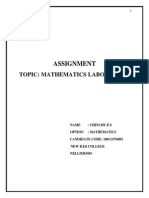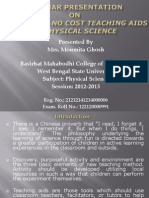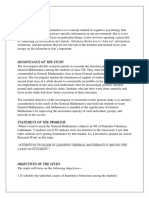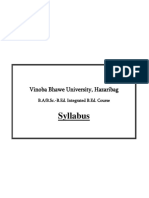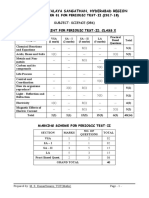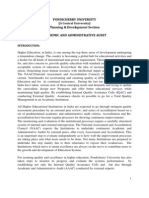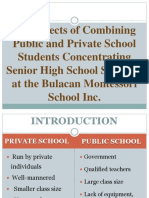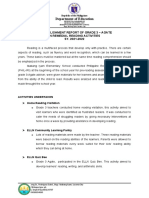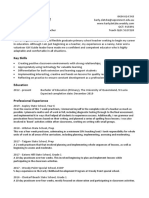Teaching and Learning Strategy in Chemistry
Teaching and Learning Strategy in Chemistry
Uploaded by
Lidya PurwasihCopyright:
Available Formats
Teaching and Learning Strategy in Chemistry
Teaching and Learning Strategy in Chemistry
Uploaded by
Lidya PurwasihOriginal Title
Copyright
Available Formats
Share this document
Did you find this document useful?
Is this content inappropriate?
Copyright:
Available Formats
Teaching and Learning Strategy in Chemistry
Teaching and Learning Strategy in Chemistry
Uploaded by
Lidya PurwasihCopyright:
Available Formats
Teaching and Learning
Strategy in Chemistry
Erlina
LEARNING THEORIES
BEHAVIORISM, COGNITIVISM, CONSTRUCTIVISM
Goals
1. THEORIES
2. MODELS
3. METHODS
4.
SCENARIO
5. LEARNING GOALS
AND ACTIVITIES
1. Theories: Behavioural
Primary Focus
Observable behaviour
Stimulus-response
connections
Assumptions
Learning is a result of
environmental forces
Subcategories
Contiguity
Respondent (Classical)
Operant (Instrumental)
Major Theorists
Thorndike
Pavlov
Watson
Skinner
Principles
Time/place pairings
Biological basis of
behaviour
Consequences
Modelling
2. Theories: Cognitive
Primary Focus
Mental behaviour
Knowledge
Intelligence
Critical Thinking
Assumptions
Learning is a result of
mental operations/
processing
Subcategories
Information Processing
Hierarchical
Developmental
Critical Thinking
Major Theorists
Bloom
Piaget
Gagne
Principles
Memory is limited
Changes in
complexity
Changes over time
Good thinking
requires standards
1.3 Theories: Humanistic
Primary Focus
Affect/Values
Self-Concept/Self-Esteem
Needs
Assumptions
Learning is a result of
affect/emotion and goal-
orientation
Subcategories
Affect
Motivation/Needs
Self-concept
Self-esteem
Major Theorists
Rogers
Maslow
N. V. Peale
Principles
Individual
uniqueness
Self-determination
Dreams and goals
are vital for success
4. Theories: Social Cognition
Primary Focus
Modelling
Vicarious Learning
Attitudes
Goals
Assumptions
Learning is a result of
influences of social
environment on thinking.
Subcategories
Observational (Social)
Self-efficacy
Goal-setting
Self-regulation
Major Theorists
Bandura
Vygotsky
Sears
Principles
Reciprocal
determinism
Individual
responsibility
3. Methods: Putting theories and models together
Adapted from Romiszowski, 1984
3.1 Methods: How do you think?
The Block Problem:
Visualisation
Draw a picture
Mathematically
How did you do it?
Were you successful on the first or second attempt?
Did you use more than one strategy?
(ie. Visualise and deduce that blocks have eight corners)
3.1 Methods: How do you think?
The Sticks Problem:
Visualising
Drawing
Manipulating Objects
If you manipulate objects:
Be aware of how it feels to do solve the problem this way.
Are you carrying on a verbal dialogue (verbalizing)? .
3.1 Methods: How do you think?
The Who Did It problem:
In this problem only one statement is true. Determine
from the information given who did it?
A said, "B did it."
B said, "D did it."
C said, "I did not do it."
D said, "B lied when he said I did it."
Verbal/Logical solution
Easy to confuse the information statement with the problem statement:
Many learners try to figure out which statement is a true,
rather than which person is guilty.
3.1 Methods: How do you think?
The Who Did It problem continued:
Begin by assuming A is guilty,
determine if it is the case that only one
statement is true, then assume B is
guilty, and so on until you find that only
one statement is true.
(This method is most common for
those who do solve the problem, and
will result in a correct answer)
If you noticed that since only one
statement is true and C says that he didn't
do it, one need only discover that one of
A, B, or D is telling the truth to establish
that C is guilty (if A, B, or D is true, C is
false; thus C did it). Since B and D
contradict each other, only one of them
can be true. Since we've found one true
statement (it doesn't matter whether it's B
or D), we can deduce that C did it.
(A more efficient, but often overlooked
strategy).
Background Information
Learning theories allow teachers to better understand
the process of learning.
Together with the use of technology, learn theories
have made a significant impact in the classroom.
There are many learning paradigms, however,
behaviorism, cognitivism and constructivism will be the
focus for this lesson.
Behaviorism
The theory originates from the works of Ivan Pavlovs, classical
conditioning, and B. F. Skinners, operant conditioning.
Classical Conditioning is when an unconditioned stimulus and
response is manipulated with a conditioned stimulus to create a
conditioned response.
Operant Conditioning is a controlled response with a reward/
punishment system according to the behavior.
The learner needs reinforcements to keep interest.
Stimuli are effective in controlling behavior.
As a result, the behaviors can be measured to record learning success.
Cognitivism
Information Processing looks at how information is retrieved and
stored.
This theory focuses on how to store and retrieve information.
Learning is attained through rehearsal and consistent use of the
information.
Retention strategies such as breaking down information and
comparing the information to long term storage are great techniques.
Constructivism
Constructivism views learning as a process in which the learner
constructs knowledge based on their past experiences.
The teacher only acts as a facilitator who encourages students to
explore within a given framework.
Learners may collaborate with others
to organize their ideas and learn from
each other to construct their own
knowledge.
Putting It All Together
Learning Theory Learning Process Technology Support
Behaviorism
Through positive/
negative
reinforcement and
punishment
Educational software
can be used to
measure the students
assessment
Cognitivism
Rehearsing
information and then
storing it for long term
use
Flashcards and
memory games can
help retain information
taught in a lesson
Constructivism
Constructing ones
own knowledge
through past
experiences and
group collaboration
Group PowerPoint
projects allow students
to work together and
combine their
knowledge to learn
EFFECTIVE TEACHER
Introduction
How to become an effective teacher?
There are 4 factors that effective teacher
must do, which are:
1. engage in quality planning and
preparation
2. Prepare a positive classroom environment
3. Use proven instructional technique
4. Exhibit professional behaviour
Objectives
After completing this chapter you should
be able to :
1. Define teaching and explain the concept
of teaching as an art and as a science
2. Describe the characteristic and skills
associated with effective teaching and
reflective teaching as well as the
constructivist approach to learning
3. Differentiate among the five categories of
time found in schools
4. Describe the expectation and standards
associated with teaching and learning
5. Explain why teachers need an
understanding of students
6. Discuss the importance of and technique
for teaching students how to learn
Definition
Moore (2001), teaching as the actions of
someone who is trying to assist others to
reach their fullest potential in all aspects of
development.
Is teaching an art or science?
Some expert says that: teachers are born
not made and the ability to be an effective
teacher cannot be taught and good
teaching is primarily creative art.
Others argue that teaching is a science
with specific laws and principles that
can be taught.
What do you think? Is teaching an art or science? Give
an argumentation to this statement.
Natural teaching
instinct
Learned teaching
principles
The most important thing is teaching needs skills, so what do you
think about it?
Art Science
Exactly what is effective teaching?
Effectiveness depends on the subject,
students, and environmental conditions.
According to National Commission on
Teaching & Americas Future, 1996: teacher
knowledge and what teacher do are the most
important influences on what students learn.
Based on research, the important elements of
effective teaching are: teacher knowledge of
subject matter, student learning, and teaching
methods.
Others opinion about effective teaching that teacher
must be prepared to be self-monitoring individuals. (dia
dapat memonitor dirinya)
Self monitoring requires that teacher have skills that
enable self-analysis of teaching episodes, they reflect
and focus on events rather than on personalities and
on systematic observation for patterns and trends in
teaching and learning behavior.
The contradiction
This contrasting ideas suggest that to be
effective teacher must inquire into students
experiences and build an understanding of
learners and capacity to analyze what occurs in
classroom and in the lives of their students.
The effect is: teacher must change their
orientation from a view of teaching as static
with simple formulas, to teaching as dynamic
and ever changing.
A reflective teacher
Reflective teacher
Learn everything about teaching from both theory and
practice.
They teach and reflect on the teaching
Think deeply about the theory and practice
So, they become sensitive to diversity of students needs
and family background.
They always ask how to make learning process succeed,
how to improve students achievement? What can I do to
make my students motivated?
Summary
Effective teachers know that good
teaching is more than simply explaining,
lecturing and discussing. To be effective
teachers must be well organized.
Organized Teachers
Organized means that teacher prepare
everything that they need in teaching.
They must have plan what to do,
knowledge about the subject matter and
skills how to teach.
Danielson (1996), found that effective teachers
need:
1. A knowledge of content and pedagogy (know their subject and
how to teach it)
2. A knowledge of students (know how students learn and develop)
3. The ability to select instructional goals (set appropriate
expectations)
4. A knowledge of resources (can locate the material and people that
will enhance instruction)
5. The ability to design instruction (can plan effective lesson plans),
and
6. The ability to design students evaluation (can design fair and
meaningful evaluation)
Karakteristik Ilmu Kimia
Menurut Middlecamp & Kean (1985):
1. Sebagian besar memuat materi yang
abstrak
2. Objek yang dipelejari merupakan
penyederhanaan dari yang sebenarnya
3. Materi berurutan dan berkembang serta
berjenjang
4. Tidak hanya berisi soal-soal hitungan
Menurut Mary B.Nakhleh (Asal dari
Purdue Uni,USA) (1991), Robert Bob
Bucat (UWA ,Autralia) (1992), kimia
memiliki dua aspek pemahaman, yaitu:
1. Konseptual, konsep-konsep, seperti:
partikel, hukum dasar kimia
2. Algoritmik, hitungan, memuat rumus-
rumus matematika, seperti stoikiometri
Menurut Johnston (1991) dalam Gabel
(1999), kimia dapat direpresentasikan
melalui 3 level multipel representasi, yaitu:
1. Makroskopik, sesuatu yang dapat dilihat
oleh mata telanjang
2. Simbolik, simbol-simbol
3. Mikroskopik, level partikulat, tidak dapat
dilihat dengan mata telanjang.
Aplikasi Pembelajaran Kimia
dlm Domain Kognitif
1. Pengetahuan konkret ttg karakteristik
kimia
- Peristilahan
cth: arti rumus kimia, bilangan kuantum,
biloks dll
- Fakta khusus
cth: Lambang dari senyawa tertentu,
nama unsur yang menyusun senyawa dll
2. Pengetahuan metodis
- Pengetahuan ttg konvensi (aturan)
Cth: konversi nama bahan dgn rumus kimia atau sebaliknya, cara
menulis kulit atom dalam konfigurasi elektron dll.
- Peng. ttg berlangsungnya waktu
Cth: penguraian seny. dari unsur2nya, perkembngan teori atom,
dll.
- Peng. ttg klasifikasi
cth: klasifikasi dlm zat murni, campuran, senyawa, bagan tingkat
energi, dll.
- Peng. ttg kriteria
Cth: kriteria/ciri utk membedakan atom, senyawa, campuran atau
kriteria elektron dlm dan elektron luar/valensi, atau perbedaan
unsur2 berdasarkan golongan dan periode, dll.
- Peng. ttg cara
Cth: cara pemisahan, langkah2 percobaan yang dilakukan
Rutherford, dll.
3. Pengetahuan abstrak
- Pengetahuan mengenai prinsip dan
generalisasi
Cth: hukum kekekalan massa, prinsip-
oktet dan duplet, dll
- Pengetahuan teori dan struktur
Cth: memahami struktur suatu molekul
dan bisa memodelkan, mengaitkan antara
teori dengan aplikasi
Pemahaman
Penerjemahan/translasi
cth: mengungkapkan reaksi kimia dengan perantaraan
persamaan atau sebaliknya, penerjemahan susunan
atom suatu unsur kepada cara penulisan orbital, dll
Interpretasi
Cth: kelarutan berbagaqi bahan, menentukan tempat
unsur dlm sistem periodik berdasarkan susunan
elektronnya
Ekstrapolasi
cth: memperkirakan pengaruh suhu, jumlah bahan
pelarut dalam larutan atau sebaliknya, dll.
Penerapan
Cth: menguraikan campuran reaksi suatu
rx ttt dlm komponen2nya dan membuat
pernyataan kualitatif maupun kuantitatif ttg
kelangsungan rx tsb, dpt mengenali sifat
persenyawaan dlm senyawa kimiadg
perantaraan perbedaan keelektronegatifan
Analisis
Analisis unsur
Cth: Air dpt digunakan sbg pelarut, tp tdk utk semua zat.
Analisis hubungan
Cth: mengetahui hub. antara pelarut dengan zat terlarut
melalui prinsip polar dan nonpolar atau like dissolve like,
hub. Antara energi pembentukan dengan kestabilan
senyawa.
Analisis prinsip penataan
Cth: dengan pembagian unsur dlm sistem periodik
berdasarkan golongan dan periode, unsur-unsur
tersebut ditata menurut elektron valensi dan jumlah
proton
Sintesis
Komunikasi individual
Cth: urutan langkah2 dlm percobaan
Pembuatan rencana
Cth: merencanakan percobaan atau eksperimen
utk memecahkan suatu masalah (pemisahan,
kadar/komposisi, dll)
Penjabaran sistem hub. Abstrak
Cth: skema pembagian bahan, memadukan
semua persenyawaan dlm suatu bagan dg
mengkombinasikan jenis-jenis orbital
Penilaian(Evaluasi)
Penilaian menurut bukti intern
Cth: kegunaan model partikel utk menjelaskan
reaksi kimia
Penilaian menurut bukti ekstern
Cth: arti pemisahan bahan, guna melindungi
lingkungan, menarik kesimpulan dari
pengetahuan yang dimiliki mengenai susunan
atom dan senyawa kimia thd kemungkinan
terjadinya dan terdapatnya unsur di alam
Kesimpulan
Berdasarkan uraian di atas, untuk
mengajarkan Ilmu kimia membutuhkan
strategi, pendekatan, metode, dan teknik
tertentu, yang disesuaikan dengan materi
dan karakteristik siswa.
Definition
Pendekatan pembelajaran dapat diartikan
sebagai titik tolak atau sudut pandang kita
terhadap proses pembelajaran, yang merujuk
pada pandangan tentang terjadinya suatu
proses yang sifatnya masih sangat umum, di
dalamnya mewadahi, menginsiprasi,
menguatkan, dan melatari metode pembelajaran
dengan cakupan teoretis tertentu
Dilihat dari pendekatannya,
pembelajaran terdapat dua jenis
pendekatan, yaitu: (1) pendekatan
pembelajaran yang berorientasi atau
berpusat pada siswa (student centered
approach) dan (2) pendekatan
pembelajaran yang berorientasi atau
berpusat pada guru (teacher centered
approach).
Strategi pembelajaran.
Dari pendekatan pembelajaran yang telah ditetapkan
selanjutnya diturunkan ke dalam Strategi
Pembelajaran. Newman dan Logan (Abin Syamsuddin
Makmun, 2003) mengemukakan empat unsur strategi
dari setiap usaha, yaitu:
Mengidentifikasi dan menetapkan spesifikasi dan
kualifikasi hasil (out put) dan sasaran (target) yang harus
dicapai, dengan mempertimbangkan aspirasi dan selera
masyarakat yang memerlukannya.
Mempertimbangkan dan memilih jalan pendekatan
utama (basic way) yang paling efektif untuk mencapai
sasaran.
Mempertimbangkan dan menetapkan langkah-langkah
(steps) yang akan dtempuh sejak titik awal sampai
dengan sasaran.
Mempertimbangkan dan menetapkan tolok ukur (criteria)
dan patokan ukuran (standard) untuk mengukur dan
menilai taraf keberhasilan (achievement) usaha.
Jika kita terapkan dalam konteks pembelajaran, keempat
unsur tersebut adalah:
Menetapkan spesifikasi dan kualifikasi tujuan
pembelajaran yakni perubahan profil perilaku dan pribadi
peserta didik.
Mempertimbangkan dan memilih sistem pendekatan
pembelajaran yang dipandang paling efektif.
Mempertimbangkan dan menetapkan langkah-langkah
atau prosedur, metode dan teknik pembelajaran.
Menetapkan norma-norma dan batas minimum ukuran
keberhasilan atau kriteria dan ukuran baku keberhasilan.
You might also like
- Chemistry CurriculumDocument8 pagesChemistry CurriculumKevon KbulimoNo ratings yet
- Maths-II Sem PDFDocument28 pagesMaths-II Sem PDFHema RamaswamyNo ratings yet
- Mathematics Assignment PDFDocument16 pagesMathematics Assignment PDFrafiaNo ratings yet
- English For Specific PurposesDocument7 pagesEnglish For Specific PurposesEmenheil Earl EdulsaNo ratings yet
- Catalysing Quality Academic ResearchDocument15 pagesCatalysing Quality Academic ResearchPrakash VadavadagiNo ratings yet
- Science Class X Periodic Test II Sample Paper 03Document4 pagesScience Class X Periodic Test II Sample Paper 03hweta173No ratings yet
- Art Integration CircularDocument19 pagesArt Integration CircularUmang KatàçgcNo ratings yet
- Mathematics LabDocument9 pagesMathematics Labchinchustephen100% (1)
- The National Policy On Information and Communication Technology (Ict) in School EducationDocument38 pagesThe National Policy On Information and Communication Technology (Ict) in School Educationnao1111No ratings yet
- ECT 305 Subject Methods ChemistryDocument126 pagesECT 305 Subject Methods ChemistryKeybateNo ratings yet
- A Comparative Study of Analytic and Synthetic Method of Teaching MathematicsDocument2 pagesA Comparative Study of Analytic and Synthetic Method of Teaching MathematicsMrinal SealNo ratings yet
- Managing School-Based Assessment: Challenges and Solutions For Educational PracticeDocument23 pagesManaging School-Based Assessment: Challenges and Solutions For Educational PracticerNo ratings yet
- Assignment # 1 NAME:Mohsin Raza CODE:BZ664692 CODE:8623 Allama Iqbal Open University IslamabadDocument23 pagesAssignment # 1 NAME:Mohsin Raza CODE:BZ664692 CODE:8623 Allama Iqbal Open University IslamabadNimra KhurramNo ratings yet
- Risk Assessment Experiment 3: Molar Solubility and Solubility Product of Calcium HydroxideDocument8 pagesRisk Assessment Experiment 3: Molar Solubility and Solubility Product of Calcium HydroxideRafi YdNo ratings yet
- Internal Quality Assurance Cell Faculty Feedback Form: 1.curriculum Design and DevelopmentDocument4 pagesInternal Quality Assurance Cell Faculty Feedback Form: 1.curriculum Design and DevelopmenturvashiNo ratings yet
- Presentation On Teaching Methodology in ChemistryDocument40 pagesPresentation On Teaching Methodology in ChemistrySubhav AdhikariNo ratings yet
- Syllabus For B.ed From Mangalore University - 2semDocument31 pagesSyllabus For B.ed From Mangalore University - 2semDivya NayakNo ratings yet
- Chemistry Paper01 SolvedDocument16 pagesChemistry Paper01 SolvedNuan Ting NgNo ratings yet
- Unit I Aims and Objectives of Teaching PDocument94 pagesUnit I Aims and Objectives of Teaching PBoce100% (1)
- in Physical ScienceDocument16 pagesin Physical ScienceRiya MukherjeeNo ratings yet
- Attention Problem in Learning General Mathematics Among The Class Vii StudentsDocument1 pageAttention Problem in Learning General Mathematics Among The Class Vii StudentsChayanika Das100% (1)
- CBSE Class 10 Blueprint 2019 All Subjects Chapter Wise Marking SchemeDocument5 pagesCBSE Class 10 Blueprint 2019 All Subjects Chapter Wise Marking SchemeSabha NayaghamNo ratings yet
- Physics - Invexzxzxzzxxxxxxxxxxxxxxxxxstigatory - Project Coverpage, Certificate, AknowledgeDocument3 pagesPhysics - Invexzxzxzzxxxxxxxxxxxxxxxxxstigatory - Project Coverpage, Certificate, Aknowledgebosefe6716No ratings yet
- Kendriya Vidyalaya Sangathan, Mumbai Region: Sample Question PaperDocument4 pagesKendriya Vidyalaya Sangathan, Mumbai Region: Sample Question PaperYash BhagatNo ratings yet
- Principles of Language Across The CurriculamDocument7 pagesPrinciples of Language Across The CurriculamPraveena, LNo ratings yet
- Challenges of Teaching Business StudiesDocument39 pagesChallenges of Teaching Business StudiesDebby Wura AbiodunNo ratings yet
- Secondary School Certificate Board (SSC)Document11 pagesSecondary School Certificate Board (SSC)Jigna Khoyani0% (1)
- Maths ProjectDocument26 pagesMaths ProjectBibu HazraNo ratings yet
- Relationship of Science With Other StreamsDocument2 pagesRelationship of Science With Other StreamsVimal Dhiman50% (4)
- Chemistry Action Plan 22-23Document5 pagesChemistry Action Plan 22-23Sharath PNo ratings yet
- Problems Facing Science Teachers in PublDocument12 pagesProblems Facing Science Teachers in PublEquity KonceptsNo ratings yet
- 1.6 Scope of Physical ScienceDocument9 pages1.6 Scope of Physical ScienceJulius Macaballug100% (1)
- Syllabus For Educational Courses in Integrated BED VBU Hazaribag PDFDocument112 pagesSyllabus For Educational Courses in Integrated BED VBU Hazaribag PDFRajeev Ranjan100% (1)
- Circle Theorem 1Document3 pagesCircle Theorem 1yaw197No ratings yet
- Physics Laboratory TechnicianDocument5 pagesPhysics Laboratory TechnicianMAGU_MWENYEWENo ratings yet
- Textbook Analysis B Ed MathematicsDocument9 pagesTextbook Analysis B Ed Mathematicsrplmhzrk17No ratings yet
- SASTRAPOSHINIDocument14 pagesSASTRAPOSHINImuhsinarijasNo ratings yet
- 604 CAI Program On GeographyDocument17 pages604 CAI Program On GeographySourav bhattacharyyaNo ratings yet
- Linear Programmed InstructionDocument6 pagesLinear Programmed InstructiondontknowNo ratings yet
- Research ProposalDocument4 pagesResearch ProposalAnonymous cm3q67h3MY100% (1)
- Final Prospectus BEd Spring 2024Document66 pagesFinal Prospectus BEd Spring 2024govt.sihsNo ratings yet
- Science Class X Periodic Test II Sample Paper 01Document3 pagesScience Class X Periodic Test II Sample Paper 01garNo ratings yet
- UNIT 4 Aromaticity and Aromatic CompoundsDocument14 pagesUNIT 4 Aromaticity and Aromatic CompoundsveluselvamaniNo ratings yet
- CCE Study Notes For CTETDocument5 pagesCCE Study Notes For CTETSuhaniNo ratings yet
- Contemporary IndiaDocument8 pagesContemporary IndiaSriram GopalanNo ratings yet
- Curriculum / Scheme of Studies of Bachelor of Science in Chemistry (BS Chemistry) (Revised in 2018)Document154 pagesCurriculum / Scheme of Studies of Bachelor of Science in Chemistry (BS Chemistry) (Revised in 2018)MUQQADAS KHANNo ratings yet
- Lec 3. Teaching of MathematicsDocument7 pagesLec 3. Teaching of MathematicsAhmad Shah100% (1)
- 8624 Important Questions A23 M.jabeRDocument27 pages8624 Important Questions A23 M.jabeRAmmara BibiNo ratings yet
- Chandan Roy's Presentation On 'Problems of Dropout in Primary Schools"Document23 pagesChandan Roy's Presentation On 'Problems of Dropout in Primary Schools"Chandan Roy0% (1)
- Instructions To QP SettersDocument2 pagesInstructions To QP SettersBALAKRISHNANNo ratings yet
- Difference Between Micro Lesson Plan and Macro Lesson Plan: Similar ArticleDocument2 pagesDifference Between Micro Lesson Plan and Macro Lesson Plan: Similar ArticlegeetaNo ratings yet
- Why Is Research A Cyclical Process?Document17 pagesWhy Is Research A Cyclical Process?Rodrick RamosNo ratings yet
- B.Ed. First Semester (C.B.S.) Examination 104: Educational Technology and Computer Assisted Instruction (Compulsory)Document3 pagesB.Ed. First Semester (C.B.S.) Examination 104: Educational Technology and Computer Assisted Instruction (Compulsory)VarunNo ratings yet
- NBA Course File LabelDocument3 pagesNBA Course File LabelMa SeenivasanNo ratings yet
- Normative TheoriesDocument11 pagesNormative TheoriesKristel Joy ManceraNo ratings yet
- 14 Yoursmartclass-Com-Action-Research-On-The-Lack-Of-Interest-In-The-Classroom-AmpDocument19 pages14 Yoursmartclass-Com-Action-Research-On-The-Lack-Of-Interest-In-The-Classroom-Ampcemepe10400% (1)
- SynopsisDocument9 pagesSynopsisraisNo ratings yet
- NTS AJK 2024 Test 001Document9 pagesNTS AJK 2024 Test 001Muhammed Habib KhanNo ratings yet
- Multiple Choice Questions (MCQ) Topic Quiz 5.3 Transition ElementsDocument13 pagesMultiple Choice Questions (MCQ) Topic Quiz 5.3 Transition Elementsrabab elkomyNo ratings yet
- 6.SOCE Career Counselling PPT 3.6.2020Document45 pages6.SOCE Career Counselling PPT 3.6.2020hemprasadbadgujar100% (1)
- Integrative ReviewerDocument16 pagesIntegrative ReviewerSheila Mae CaballaNo ratings yet
- Lesson 4 Year 9 HassDocument2 pagesLesson 4 Year 9 Hassapi-496451435No ratings yet
- Act100 Sap Activate MethodologyDocument4 pagesAct100 Sap Activate MethodologyLos VizuetinesNo ratings yet
- Frank Mockler - ICT in Education OverviewDocument13 pagesFrank Mockler - ICT in Education OverviewWes BoudahNo ratings yet
- Meta Coach ReflectionsDocument134 pagesMeta Coach ReflectionsvijayaNo ratings yet
- Innovation in EducationDocument12 pagesInnovation in EducationEmmanuel PierreNo ratings yet
- Synthesis and Application of Key Concepts and Principles Through Demonstration TeachingDocument39 pagesSynthesis and Application of Key Concepts and Principles Through Demonstration TeachingRica Mae Alimen100% (1)
- Academic Audit ManualDocument33 pagesAcademic Audit Manualsabs123456108050% (2)
- Perspectives Advanced Students BookDocument3 pagesPerspectives Advanced Students Booksudeozkocaer75No ratings yet
- Detailed Lesson Plan FormatDocument5 pagesDetailed Lesson Plan FormatLeslie Felicia Peritos-FuentesNo ratings yet
- Argumentative ParagraphDocument2 pagesArgumentative ParagraphAlice LopzzNo ratings yet
- Activity 8: Teaching Internship Eportfolio ActivityDocument9 pagesActivity 8: Teaching Internship Eportfolio ActivityJessica LamzonNo ratings yet
- Teaching Engineering and Technology Barak 2012Document19 pagesTeaching Engineering and Technology Barak 2012Yee Jiea PangNo ratings yet
- The Effects of Combining Public and Private School Students Concentrating Senior High School Students at The Bulacan Montessori School IncDocument15 pagesThe Effects of Combining Public and Private School Students Concentrating Senior High School Students at The Bulacan Montessori School Incleo abuanNo ratings yet
- Lesson Plan in English 8 Unfamiliar WordsDocument3 pagesLesson Plan in English 8 Unfamiliar WordsCristine Joy GardoceNo ratings yet
- InformerDocument2 pagesInformerHarris KianiNo ratings yet
- Lesson Plan and ProductDocument4 pagesLesson Plan and Productapi-435897192No ratings yet
- ACCOMPLISHMENT REPORT OF GRADE 3-ReadingDocument2 pagesACCOMPLISHMENT REPORT OF GRADE 3-ReadingMaam Riza Sasot100% (4)
- ReportDocument7 pagesReportDan PradesNo ratings yet
- WWW - Smude.edu - In: Prospectus - Fall 2010Document36 pagesWWW - Smude.edu - In: Prospectus - Fall 2010nageshrdNo ratings yet
- ResumeDocument2 pagesResumeapi-330392338No ratings yet
- Notes and Ideas Flow Chart School Vision: Key Question Action QuestionsDocument1 pageNotes and Ideas Flow Chart School Vision: Key Question Action QuestionsLyn RossNo ratings yet
- English For MidwiferyDocument32 pagesEnglish For Midwiferykhinanti giantariNo ratings yet
- Bridging The Gap Between Second Language Acquisition Research and Memory Science: The Case of Foreign Language AttritionDocument8 pagesBridging The Gap Between Second Language Acquisition Research and Memory Science: The Case of Foreign Language AttritionCharlene OliverosNo ratings yet
- Burns 419 PortfoliooutcomesessayDocument22 pagesBurns 419 Portfoliooutcomesessayapi-489861652No ratings yet
- Kirsten Marquis: Skills and InterestsDocument1 pageKirsten Marquis: Skills and Interestsapi-251240284No ratings yet
- Dll-8-2-Multiplication and Division of Rational Algebraic ExpressionDocument9 pagesDll-8-2-Multiplication and Division of Rational Algebraic ExpressionHero MirasolNo ratings yet
- Ethical DilemmaDocument4 pagesEthical Dilemmaapi-223268993No ratings yet
- U14 - Lesson 2 - Oxford Grammar For Schools 3 - LP - LinhDocument5 pagesU14 - Lesson 2 - Oxford Grammar For Schools 3 - LP - LinhLinh ChuNo ratings yet
- The Problem and Its BackgroundDocument23 pagesThe Problem and Its BackgroundJerwin CanterasNo ratings yet







